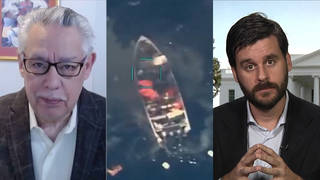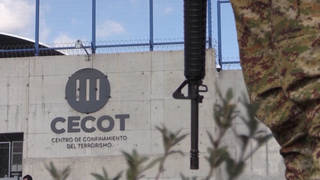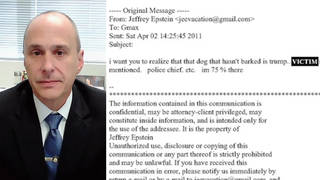
We speak with Jack Spadaro, the former head of the National Mine Health and Safety Academy, a branch of the Department of Labor. Spadaro discusses how we was forced out of his job as he attempted to investigate a 2000 mining accident. We are also joined by Hillary Hosta with the West Virginia-based Coal River Mountain Watch. [includes rush transcript]
Critics contend that the Bush administration is beholden to the mining industry and has gutted safety and health regulations in the mines. They point to figures from the Center for Responsive Politics which show that over the last 6 years, coal companies gave $9 million to mostly republican federal candidates. Critics also point out that Bush cut funding for mine safety enforcement by $15 million and stacked the Mine Safety and Health Administration with representatives of corporate interests.
In 2002, Bush named former Massey Energy official Stanley Suboleski to the MSHA review commission that decides all legal matters under the Federal Mine Act. Massey Energy is one of the largest coal companies in the U.S and has been cited for numerous violations. And David Lauriski, the former head of MSHA, spent 30 years as an executive in the mining industry before being tapped to head the agency. He resigned last year to work for a mine-industry consulting company. The current head of MSHA, Richard Stickler, was appointed by Bush last September. Stickler is a former manager of Beth Energy mines. The Bush administration has also cut 170 positions from MSHA.
- Jack Spadaro, mining engineer who has devoted his life to the safety of miners. He was head of the National Mine Health and Safety Academy (MSHA), a branch of the Department of Labor, which trains mining inspectors. He’s been working in federal regulatory agencies for almost 30 years. He was threatened with losing his job at MSHA after blowing the whistle on what he called a whitewash by the Bush administration of an investigation into a major coal slurry spill in 2000.
- Hillary Hosta campaigner with the West Virginia-based Coal River Mountain Watch.
- Ken Ward, staff writer for the Charleston Gazette in West Virginia. He wrote an award-winning series of articles for the paper about coal-industry abuses in West Virginia, revealing that state regulators routinely ignore the law when they issue mountaintop removal permits.
Transcript
AMY GOODMAN: We’re joined right now by Jack Spadaro. He is known as a man who has dedicated his life to the safety of miners and the families that live around mines. He’s a mining engineer. He was head of the National Mine Health and Safety Academy, a branch of the Department of Labor which trains mining inspectors. And he’s been working in federal regulatory agencies for almost three decades. He was threatened with losing his job at MSHA after blowing the whistle on what he called a whitewash by the Bush administration of an investigation into a major coal slurry spill in 2000. We welcome Jack Spadaro to Democracy Now!
JACK SPADARO: Thank you.
AMY GOODMAN: Can you start off by talking about how you almost lost your job, the enormity of the disaster at the time, and respond to what we’re seeing today, the disaster at the Sago Mine?
JACK SPADARO: Well, fortunately the disaster in 2000 — the Martin County coal slurry spill, did not result in a loss of life as that which has happened in Upshur County, West Virginia. And my heart goes out to the people there. I have actually been involved in several mine disasters over the years, and it was very difficult to watch the faces of the people there and know all that they were going through.
But the disaster in October 2000 was a spill of 300 million gallons of coal slurry into 100 miles of streams in Kentucky and West Virginia, and it killed all life forms for 100 miles downstream from the coal waste [inaudible]. And the failure occurred in the bottom of a reservoir where the flurry entered abandoned underground mine working by Massey Energy, who owned the impoundment, and then flowed into two streams that drained into the Tug Fork River. There were about — well, there were hundreds of people who were affected directly, who had slurry in their yards, against their houses, and there were thousands of people who lost their water supplies downstream. I think all together 17 communities and about 27,000 people were affected.
And there had been a previous spill in May of 1994. The company knew that there were underground mine workings beneath this reservoir because of that previous spill, and because they had actually created those underground mine workings, as well. They knew that there was a chance that something like this would happen again. But the Mine Safety and Health Administration allowed them to continue operating the impoundment. And, indeed, six years later this disaster occurred.
During the investigation, while the Clinton administration was still running the Mine Safety and Health Administration, we were allowed to do in our investigation whatever it took to get to the facts. And that lasted until January of 2001; when the Bush administration came in, we were told to stop our investigation, essentially to wrap it up. And we were nowhere near finished. And then, as we were writing the investigative report, we were continually interfered with by Dave Lauriski, the new appointee to run the Mine Safety and Health Administration, to weaken the report.
And finally, I refused. I actually resigned from the investigative team and refused to sign the final report. And I went public with my concerns, because they were trying to cover up Massey Energy’s responsibility and the agency’s responsibility, as well.
JUAN GONZALEZ: Well, [Jack] Spadaro, back in 2004 in a 60 Minutes interview, you were quoted as saying, “I’ve never seen anything so corrupt and lawless in my entire career as what I saw regarding interference with a federal investigation of that disaster.” Could you talk a little bit about what has happened with mine health and safety regulation in monitoring at the federal government level under the administration, the current administration?
JACK SPADARO: Yes. You know, I want to make it clear. I’m not being critical of the rank-and-file in the Mine Safety and Health Administration. The inspectors in the field who are doing their jobs every day are doing the very best job that they can do. I think they’re among the most committed people I’ve ever worked with in my life. And they are interested in mine health and safety.
It’s the top officials in the agency who have, over the past five years, interfered with the field operations and tried to prevent inspectors from doing their jobs. Lauriski instituted a program called “compliance assistance,” where he encouraged the inspectors to, instead of writing violations, to try to convince the operators to comply with the law. But the law is mandatory. If an inspector finds a violation, the inspector is supposed to write a citation and make sure that it gets corrected. That’s one of the reasons the agency was effective up until 2001 and had reduced over the 30-year period the numbers of fatalities and serious injuries at mines.
But now, I’ve talked in recent years with many inspectors and, in fact, two weeks ago talked with someone in the agency who’s quite knowledgeable about what was happening with the agency, and that person said, “Jack, I’m afraid that there’s going to be another mine disaster very soon, because of how poorly the agency’s being managed and because the inspectors aren’t being allowed to go forward with the kind of enforcement action they think is necessary.”
I think that may be what happened here at this mine. Although the inspectors were obviously doing their jobs of writing the citations and putting pressure on the company, they weren’t allowed to close the mine, which is what should have been done at Sago.
JUAN GONZALEZ: What about this whole — the fines under federal law, these ridiculously low fines for such major violations? Have any attempts been made over the years to increase the penalties, because these are basically nuisance fines for companies that are making millions of dollars in profits off these mining operations?
JACK SPADARO: It’s an outrage that these fines are so low. And I don’t know of any serious attempt to raise those assessments. That should have been done a long time ago. I don’t know of any administration that’s trying to raise the assessments for penalties at mine sites.
AMY GOODMAN: We’re talking to Jack Spadaro, a mining engineer who has devoted to his life to the safety of miners. Hillary Hosta is also on the line with us, campaigner with the Coal River Mountain Watch. Hillary, welcome to Democracy Now! Can you talk about coal politics in West Virginia? Where do the governor, the senators, the Congress members, where do they come down when it comes to coal owners, the company owners versus the workers?
HILLARY HOSTA: Hi there, Amy. Thanks for having me on the show. Well, it’s an interesting situation. And it’s not surprising, unfortunately, that this terrible tragedy has happened. What is surprising is that more tragedies like this don’t happen, because of weak regulations and poorly enforced regulations. And, unfortunately, if you look at some of the campaign contributions, not just statewide, but also on a national level, you begin to wonder if the weak regulations or poorly enforced regulations are really just oversights.
For example, since 1996 in West Virginia, coal interests have contributed more than $4 million to candidates that ran for governor, Supreme Court and the legislature. And over the past five election cycles, the industry contributed over $2 million to gubernatorial campaigns and inaugurals, and $1.5 million to legislative races, and about just over $500,000 to Supreme Court candidates. And that’s just on the state level.
AMY GOODMAN: How does strip mining relate to underground coal mining?
HILLARY HOSTA: Well — how does strip mining relate to underground coal mining? Well, strip mining is also regulated by weak regulations and is also, in my opinion, under-enforced. The violations across the broad throughout the entire coal extraction and processing industry are, as were noted, sort of like token fines, and they’re not commensurate with the violations that happen, so it’s actually more profitable, whether coal companies are strip mining or underground mining, to continue to violate than to actually address the issues that arise from the violations and to stop violating.
So, I have a concern that after something horrible, a horrible tragedy like the one that has just happened at the Sago Mine, that politicians in this state, in West Virginia, will begin to advocate for increased surface mining, saying that it’s safer. But actually, surface mining, whether it’s strip mining or mountaintop removal mining, doesn’t just endanger the miners, but amplifies the risk to the community that surrounds the mines.
JUAN GONZALEZ: We still have on the line also Ken Ward, investigative reporter for the Charleston Gazette. I’d like to ask Ken, what about the involvement of the United Mine Workers Union. West Virginia has always been known as sort of the center of that union and the union’s ability to have some impact on safety regulation for its members. Could you talk a little bit about that, and whether the union’s power has increased or decreased over the years on these safety issues?
KEN WARD: Well, I think that like the labor movement as a whole, membership — the percentage of the working miners in West Virginia and around the country who are represented by the Mine Workers has decreased pretty significantly. West Virginia has historically been, even up until the last few years, a state that was — had a high percentage of miners who were represented by the union. The U.M.W. does has a very active safety and health division. Dennis O’Dell, who’s the new head of that — their longtime mine safety chief, Joe Main, recently retired — Dennis O’Dell was at the site monitoring what was going on. I’m sure that they’ll have a lot to say.
After the most recent disaster before this one, in September of 2001 at the Jim Walters #5 mine outside of Tuscaloosa, Alabama, the U.M.W. did its own investigation report, highlighting all sorts of deficiencies in MSHA’s enforcement there. I think that the U.M.W. — in West Virginia its membership is more and more retired miners, in part because continued mechanization, both of underground and surface mining, is decreasing the amount of working miners.
But along with that, one of the real concerns here is that as coal prices are going up and energy prices are going up, companies, such as I.C.G. that bought out this mine, are going into what were and are marginal properties. When it did its initial public offering to try to sell stock and raise money for its new coal operations, I.C.G. said in its disclosures to potential investors that some of these mines, including the Sago Mine, had geologic and other conditions which could be problems. And so one of the things that we’re seeing is companies are going into — companies that are going into marginal areas, some of these companies are under-capitalized, they don’t have huge safety operations, and it really creates a serious risk.
But the other thing that —- and I think that that’s very important for people to understand, because the issue really with the coal industry, with all of these things, is a matter of an industry that clearly for a century or more has done a very efficient job of externalizing its true costs of doing business. You know, we ran a story in the Gazette this morning about the long list of tragedies in West Virginia. Sago now is joining a long of names: Farmington, Loveridge, Hominy Falls, Eccles, Glen Rogers, Monongah. You can go on and on and on and on. And my friends in the environmental community -—
AMY GOODMAN: And when you say you can go on and on and on, I bet most of what you just said, no one has ever heard of before.
KEN WARD: In West Virginia, they have. In Appalachia, they have. If you go up to someone in Raleigh county and say the word “Eccles,” they’ll know about that disaster. If you go up to somebody in that area and say “Hominy Falls,” they’re aware of that. Hominy Falls was Quecreek before Quecreek was. It was a flooded mine that unfortunately didn’t end with a heroic rescue like Quecreek did. Most of the people at Hominy Falls died.
My good friend Jack Spadaro, who’s on the line, could rattle these off like crazy. You know, of course, Jack started his career as the engineer in charge of investigating Buffalo Creek, the terrible tragedy in February of 1972, when 125 people were killed by the flood caused by a terribly constructed and maintained Pittston Coal dam in Logan County, West Virginia.
And the thing I wanted to add is my friends in the environmental community talk a lot about, rightly so, about the dangers of surface mining. And one of the things that I find troubling sometimes is you go to public meetings on mountaintop removal, and people stand up and say, “Well, why can’t we just mine all of this underground?” And it is a legitimate point that people make when they say that mountaintop removal and surface mining, to some extent, eliminates the danger of this kind of explosion.
However, surface mining has its own set of safety problems for workers. Drilling into big rock made of silica creates black lung and silicosis. It has its own whole set of safety problems. And it’s also important for your listeners to understand that in West Virginia, about 2/3 of the coal is still mined underground. And aside from the threat — the constant threat of these terrible sorts of tragedies — between 1,500 and 2,000 coal miners still die every year from black lung disease. An untold number of people are maimed in the mines. They lose a hand. They get hit in the head by a piece of rock and are brain damaged. It’s terrible things that go on in these mines all of the time.
And underground mining has its own huge set of environmental problems, everything from acid mine drainage to water pollution. And we’re seeing, as mining is trying to increase in these areas of Upshur County and North Central West Virginia, we’re going to see an increase, a return to the days of orange streams and red streams in that area. And plus, highly mechanized underground mining, especially in the areas of North Central West Virginia and Western Pennsylvania is undermining historic homes. My colleague Don Hopey from the Pittsburgh Post-Gazette has done a wonderful series of stories about damage to historic farmhouses and structures in that area from being undermined [inaudible].
This is really an industry that, as I said, has been incredibly efficient in externalizing its cost of doing business. And it’s important for especially the folks that listen to your program to understand that, though they may be seeing — think they’re seeing increases in their energy costs, the families of the 12 miners who died at the Sago Mine, those deaths are, in part, borne by everyone who wants low electricity costs. And people need to understand that we all are partly responsible for those deaths. And we should all mourn that.
AMY GOODMAN: Ken Ward, Jr., on that point, we have to wrap up. I want to thank you for being with us from the Charleston Gazette. Hillary Hosta, campaigner with the Coal River Mountain Watch, and Jack Spadaro, mining engineer who has devoted his life to the safety of miners and their families.












Media Options